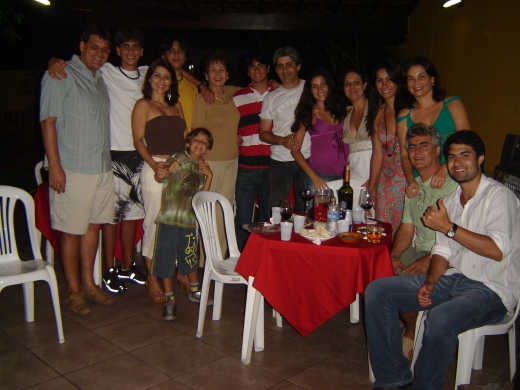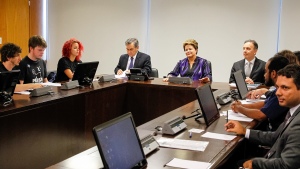O BRASIL GANHOU! A SELEÇÃO VENCEU ESPANHA NO FINAL DA COPA DAS CONFEDERAÇÕES!

The national team celebrates after the victory against Uruguay
“Brazil won! The national team beat Spain in the Confederations Cup championship!” Last Sunday night I cheered along with hundreds of young Brazilians as we watched Brazil defeat the #1 team in the world 3 to 0. Brazil scored a goal within the first 5 minutes, setting the celebratory tone for the night. I somehow ended up standing near the small group of Spanish expats who were cheering for the enemy; they got lots of good-natured taunts sent their way. The semifinal game against Uruguay was actually more exciting—a 2-1 nailbiter with good offense on both sides. You could hear fireworks and cheers over the whole city.
Brazil’s futebol games captivate the entire country. Almost every family has a TV set, even deep in the Amazon, so soccer and the nightly soap operas are two of the very few things that reach the entire nation. On any street, you can keep track of the score by the shouts of joy and disgust that emanate from every window. Walking back from a hike while visiting an outdoorsy town in the interior a few weeks ago, I could tell when Brazil scored by the cheers… and when Italy scored against them by the groans… and when Brazil (graças a Deus, thank God) scored again to win the match.

Duke’s Cameron Crazies
I’ve experienced die-hard sports fanaticism as a Duke student and Cameron Crazie, but Brazil just might have the Blue Devils beat. My 65-year-old host mother shouts at the television like a burly New England Patriots fan would shout during the last play of a close Super Bowl. “Shoot, shoot! Ah, you idiot, that was too late!” When Brazil won against Uruguay, she ran into the street to celebrate with neighbors. I followed her out and shouted, “Nós ganhamos! Ou… vocês ganharam. (We won! Or… y’all won.)” She stopped celebrating just long enough to kindly correct me—“ Nós ganhamos.”
Brazilians love soccer almost as much as they love their families. I know that I love my family, and the most Americans do, but Brazilian familial love reaches a whole new level. A young Brazilian woman I met asked me where I live in the US. I told her that my parents live in Washington, DC, while I go to school 5 hours farther south. “O que?” She thought she misheard me at first. She asked where I stayed during the week—assuming that I lived at home for the weekends, at the very least. Here (like much of the rest of the world, I guess) most children live with the parents until they marry. If they go to college, they attend a university in their city and live with their parents. When I said, “I live at my university,” I think she imagined me sleeping in an empty lecture hall. Dorms are a foreign concept; I try to convey the idea by describing apartment buildings for students of just one university who all live together, without their parents or siblings. This brasileira calls her mother every day when she’s away from home, even if she’s just visiting friends for the weekend. She doesn’t cook—because her mom still makes all her meals! (Sounds pretty good to me. College food can’t compete with my dad’s lamb-stuffed Bell peppers.)

A Brazilian extended family. Taken from a Google search, I confess, but still representative of the way everyone gets together for Sunday lunches, and the very intergenerational feel of Brazilian social life.
An exuberantly friendly 50-year-old neighbor still lives with his mother. Isn’t that a bit odd, I asked my host mother. Of course not! He never married, so why would he ever want to leave? The logic here is different. People seem to feel sorry for Americans when I tell them that most people move out around age 18. And children tend to settle close by to their parents. The 23-year-old who lives across the street from me (with his parents) took me to visit his grandmother last night after the Uruguay game; the walk took all of four minutes. His aunt also lives there, because she never married. A few minutes after entering the house, his 93-year-old grandmother gingerly took my hand and murmured something to me. She repeated herself: “Let’s get married.” I thought I had misheard until she said, “I’ve been looking for a new husband. I want a man who’s young, light-skinned, handsome, and rich.” She smiled mischievously and asked, “Oh, are you rich?”
Brazilians seem more flirtatious than Americans, although there’s often no romantic intention. It was hard to tell with my neighbor’s grandmother. But if I wanted to flirt with her more, I could probably message her on Facebook. Americans started social media, but Brazilians have brought the game to a whole new level. Instead of getting my number, new friends—and coworkers, and my 11-year-old neighbor, much to my surprise—just find me on Facebook. A call-in Catholic radio show that my host mother listens to for endless hours each day even invites listeners to find them on Facebook, I think to post prayer requests. The 99.9% peaceful protests that spread across the country last month (see my previous post) are organized and promoted over Facebook and Twitter and other sites I’m not hip enough to know about.
One last bit of cultural learning–Brazilians put thermometers in their armpits to take their temperature. Not their mouths. So when my host mom gave me a thermometer when I had a mild flu this week, she burst into laughter when she realized I had it in my mouth. It didn’t taste too great, and now I know why…












